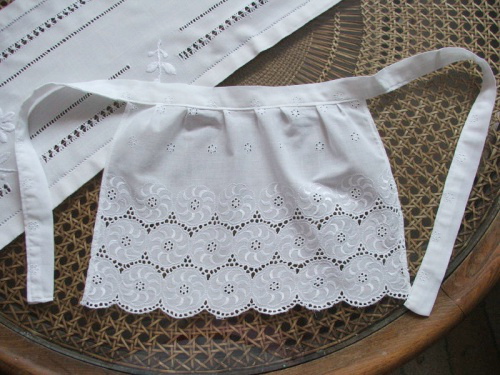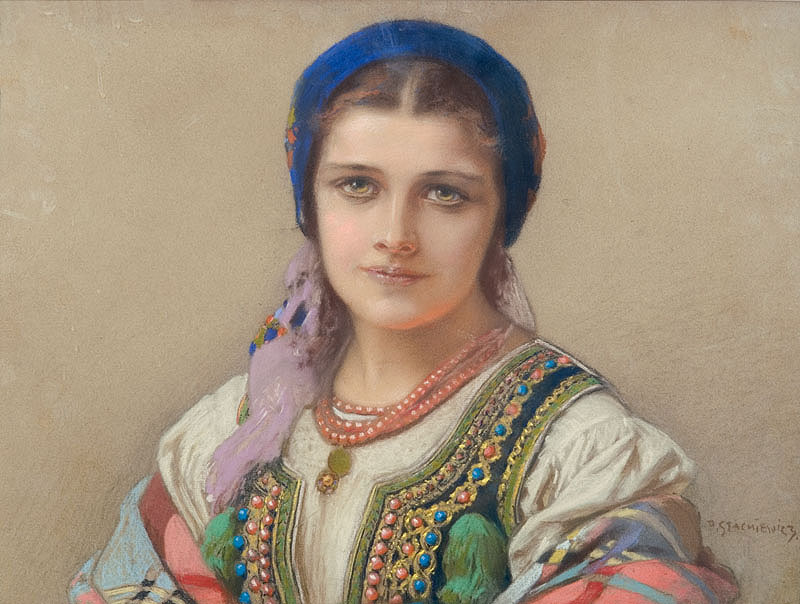Kraków costume - one of the most well-known of the Polish regional costumes, which grew to the rank of a national costume. Sadly, also the most generalized and simplified due to the modern mass-media approach in many cases. How should it look like?
 |
| © ZPiT AGH im. Wiesława Białowąsa "KRAKUS" |
Origins of the Kraków costume can be traced back to the Renaissance era, but the modern version of it started forming only around the beginning of 18th century. After the difficult times of the 19th century when Poland lost independence it gained the rank of "national costume of Poland":
A Cracow costume is the only peasants' attire which was promoted to the rank of a Polish national costume. This decision was made on patriotic grounds, with the Cracow's peasants’ participation in the Kościuszko Uprising as a main factor. Even the Uprising's leader, Tadeusz Kościuszko, used to wear the Cracow costume (so he dressed "like a peasant") just so that he would not be recognised by Russian spies. Kościuszko's popularity contributed to the popularisation of the Cracow costume among the Poles in general. Some of the costume's elements were applied to the uniforms worn by participants of the 19th century national uprisings. This popularity of the Cracowian costume, especially in its female version, was then reinforced by the Cracow’s intelligence of the Young Poland (Młoda Polska) movement, who promoted it as a new fashion. [source: The State Ethnographical Museum in Warsaw]
What most of the people know as "Kraków costume" actually varies among different villages (which in some cases have become districts of the modern city over time) around the Kraków's old center, such as: Bronowice, Tyniec, Grojec, Wieliczka, Morawica, Olszanica, and so on. However, there are many common elements that make the Kraków costume easy to recognize... and also easy to generalize. Either way, the Kraków costume allows to show a lot of individual approach in detailing, especially as it comes to women's fashion.
 |
| Approx. area of the Kraków costume in Poland within Małopolska region. |
COSTUME: MEN
One of the most characteristic, with a peacock feather being the main decoration of the headwear:
 |
| Kraków costumes © ZPiT AGH im. Wiesława Białowąsa "KRAKUS" |
Decoration of the headwear could also include a rich decoration made of several peacock feathers, flowers and additional ribbons, as in this example from Bronowice (nowadays a district of Kraków):
 |
| Kraków headwear © perfekt.krakow.pl |
...or here, picture from Korzkiew:
 |
| Kraków headwear © wiele16 via garnek.pl |
Traditionally, such rich headwear decorations were reserved for the groom on his wedding day, but could also be worn by more important figures during festive days.
There are several different types of the headwear itself (like the black żeleźniak on the picture from Bronowice above), but the most popular is red rogatywka (peaked, four-pointed cap) with short peacock feathers and black or white fur, sometimes called krakuska:
 |
| Rogatywka type of headwear © bopalinska |
Why the peacock feather? It could be explained in many ways, from it being an ancient symbol of rebirth and immortality (popular symbol on the medieval religious paintings), to the uniqueness of the peacocks - they were considered "royal" birds, therefore worn by the Cracovians to remind that the city used to be the royal capital of Poland in the past.
Next important element of the costumes is kaftan - a long sleeveless vest, usually in a dark blue, navy blue, sometimes black color and heavily decorated with red chwosty (tassels), beads and subtle embroidery. Here's the most typical version:
 |
| Kaftan from Kraków © perfekt.krakow.pl |
A group of men in blue kaftan with and red rogatywka:
 |
| © Dariusz.Biegacz |
There's another type of the vest - in a cobalt blue color with additional rich embroidery. It is popular in Kraków nowadays, but in fact (historically speaking) it was typical rather for the Kraków East costume associated with e.g. Brzesko or Zalipie regions (Kraków East will be a topic of a separated post). Here are examples of it worn by a group from Nowa Huta district of modern Kraków:
 |
| © Zespół Pieśni i Tańca NOWA HUTA |
Next typical element is a coat called sukmana, obviously worn during the colder days. It's usually white or gray (but dark blue ones are popular as well), traditionally lined inside with red material and decorated with red embroidery, tassels and metal elements as shown below:
 |
| © perfekt.krakow.pl |
Another, more minimalistic example from the 19th century:
 |
| © kedil via garnek.pl |
Here's a good guide to various examples of men coats from different Kraków regions:
 |
| Various Kraków regions and costumes © MCK Sokół |
They aren't always that plain:
 |
| © Zespół Tańca Ludowego "Harnam" |
Trousers - as it comes to the "typical" Kraków costume mandatory is white portki with red stripes (blue-striped are characteristic for the Kraków East region):
 |
| Kraków trousers [source] |
The main decoration and pride of a Cracovian man was a leather belt (pas krakowski) worn over the vest (kaftan). The most common was white, ornamented and decorated with metal beads and hanging elements:
 |
| Kraków belt © perfekt.krakow.pl |
COSTUMES: WOMEN
Here's a good example of the easy-to-spot differences between the costumes of married and unmarried women:
 |
| Lovely Cracovian women © ZPiT AGH im. Wiesława Białowąsa "KRAKUS" |
First of all - the flower wreath was worn by unmarried maidens only. The typical small "one-lined" wreaths were worn by chidren and young teens, while wreaths of the older (marriageable) girls could have a triangle "crown" shape as in the example below:
 |
| Kraków wreath © perfekt.krakow.pl |
A perfect Cracovian maiden wears also a long braid tied with a red ribbon:
 |
| © Zespół Pieśni i Tańca "Śląsk" im. Stanisława Hadyny |
On the day of the marriage bride's head was decorated with a tall flower crown with long flowery-ornamented laces. The crown's shape could vary, usually it was built out of red or white flowers:
 |
| Bride from Kraków © Krakowski Teatr Scena Stu |
Married women were covering their heads with white cloth that symbolized modesty. It looks plain at the first sight (from a distance), but in fact was beautifully ornamented:
 |
| © Zespół Pieśni i Tańca "Śląsk" im. Stanisława Hadyny |
 |
| © Zespół Pieśni i Tańca "Śląsk" im. Stanisława Hadyny |
Colorful headkerchiefs with floral ornaments were popular as well in some villages.
Main element of maiden's clothing was a richly decorated bodice (gorset) worn over a white blouse. Bodice's decorations were varying between different villages around Kraków - some preferred floral, some geometrical shapes. Here's the most popular example from Bronowice - the north-western district of modern Kraków (which was a neighbouring village just 100 years ago), commonly known as the typical Kraków costume's place of origin:
 |
| Kraków bodices © Polskie Stroje Ludowe |
...here from Tyniec, a bit south-west from the Kraków centre:
 |
| © perfekt.krakow.pl |
 |
| © perfekt.krakow.pl |
...and here from Grojec-Alwernia, located north-western from Kraków and being rather distinguished as Kraków West costume (in Polish: strój krakowiaków zachodnich):
 |
| © perfekt.krakow.pl |
Below is a closeup of a beautiful bodice decorated with natural corals and metal clasps from "Rydlówka" Museum in Bronowice, coming from the early 20th century:
 |
| Bodice of Jadwiga Rydlowa, early 20th century © Rydlówka |
Very characteristic and richly decorated element of female clothing is also the jacket called katanka (plural form: katanki), beloved by the artists and often depicted on the 19th and early 20th century paintings. They were rather worn by married women. Varying in colors a lot, they were always beautifully embroidered and decorated with beads, natural corals, sequins and tassels according to a certain pattern:
 |
| Kraków katanka, front and back view © perfekt.krakow.pl |
 |
| © perfekt.krakow.pl |
 |
| © Zespół Pieśni i Tańca "Śląsk" im. Stanisława Hadyny |
Great side view of katanka:
 |
| © Zespół Pieśni i Tańca "Śląsk" im. Stanisława Hadyny |
Blouses worn by Cracovians were white (symbol of purity and modesty), decorated with white ornaments around the collar and cuffs (sometimes also at the bottom of the blouse), very often with additional laces. Below's an example from the Ethnographic Museum of Kraków:
 |
| © Muzeum Etnograficzne im. Seweryna Udzieli w Krakowie |
Another, modern example with tatted collar and cuffs:
 |
| © Polskie Stroje Ludowe |
Beautiful detailing of the collar and cuffs over katanka:
 |
| © Zespół Folklorystyczny Wielopolanie |
Modern and currently the most common machine-made ornaments:
 |
| © Zespół Pieśni i Tańca UJ SŁOWIANKI |
Skirts of Cracovian women were very colorful, usually made of the so-called "Tibetan" material (Tybet) with various floral patterns. The most common for Kraków would be those on black or red background, although there isn't any rule in that particular matter:
 |
| Examples of the so-called "Tibetan" material [source] |
Aprons were worn over the skirt (fartuch or fartuszek). Young maidens often preferred very detailed ones, made of tulle and laces (semi-transparent):
 |
| © perfekt.krakow.pl |
Other examples of hand-made embroidery on a tulle apron:
 |
| © perfekt.krakow.pl |
Married women were rather wearing white cotton aprons (sometimes called zapaska), which also were decorated with subtle white embroidery:
 |
| © perfekt.krakow.pl |
 |
| Children's apron [source] |
Cracovian women weren't using much jewellery (the bodice was their main decoration), the most desirable pieces were red coral necklaces (korale), traditionally decorated with a holy medallion. Here I'm heavily disappointed, as great majority of the modern examples are inadequate, therefore I'll illustrate how should it look like with an old painting:
 |
| Piotr Stachiewicz "Krakowianka", pic. © AgraArt |
 |
| [source] |
RESOURCES: PATTERNS
---
This article might be supplemented in the future.
Please leave a credit to lamus-dworski.blogspot.com in case of quoting ♥

No comments:
Post a Comment